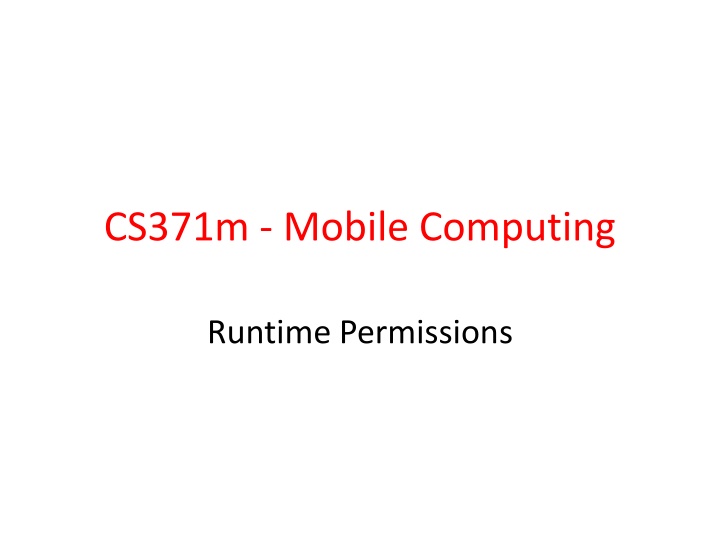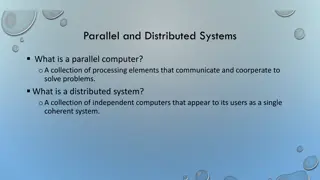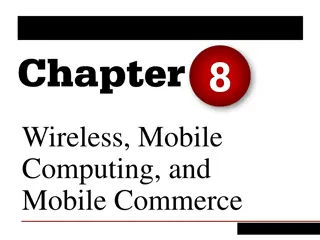CS371m - Mobile Computing
Explore the different ways apps can request permissions on Android devices, such as at compile time, install time, or runtime. Learn about the history of permissions pre-Android 6.0 and what happens when apps lack necessary permissions.
Download Presentation

Please find below an Image/Link to download the presentation.
The content on the website is provided AS IS for your information and personal use only. It may not be sold, licensed, or shared on other websites without obtaining consent from the author.If you encounter any issues during the download, it is possible that the publisher has removed the file from their server.
You are allowed to download the files provided on this website for personal or commercial use, subject to the condition that they are used lawfully. All files are the property of their respective owners.
The content on the website is provided AS IS for your information and personal use only. It may not be sold, licensed, or shared on other websites without obtaining consent from the author.
E N D
Presentation Transcript
CS371m - Mobile Computing Runtime Permissions
Clicker If your app wants to access the users contacts when do you request permission to do this? A. Never, its not necessary B. At compile time C. At install time D. At runtime E. It depends
System Permissions In an attempt to maintain security (system integrity, user privacy) on Android devices run each app in a limited sandbox If app wants to use resources (e.g. camera, storage, network) or information (e.g. contacts info) outside of sandbox, must request permission. List of permissions: https://developer.android.com/reference /android/Manifest.permission.html
History of Permissions Prior to Android version 6.0, Marshmallow Apps requested permission at install time Permissions Listed in the AndroidManifest.xml File
Install Time Permissions Pre 6.0 / Marshmallow user granted permission at install time. Google Play listed permissions for app when install selected Based on permissions listed in manifest Some apps we own you
Clicker What happens if an app tries to use a resource or access information it doesn t have permission to use? A. Compile error B. Runtime error C. Nothing, app allowed to access info or resource D. Nothing, BUT app not allowed to access info or resource, a NO-OP
Lacks Permission App stopped by system as soon as it tries to perform operation it doesn t have permission for 02-09 16:03:39.857 26846-26846/org.example.locationtest E/AndroidRuntime: FATAL EXCEPTION: main Process: org.example.locationtest, PID: 26846 java.lang.RuntimeException: Unable to start activity ComponentInfo {org.example.locationtest/org.example.locationtest.LocationTest}: java.lang.SecurityException: "passive" location provider requires ACCESS_FINE_LOCATION permission. at android.location.LocationManager.getProvider(LocationManager.java:383) at org.example.locationtest.LocationTest.dumpProvider(LocationTest.java:372) at org.example.locationtest.LocationTest.dumpProviders(LocationTest.java:364) at org.example.locationtest.LocationTest.onCreate(LocationTest.java:80)
Viewing Permissions A user can see what permissions an app has in Settings -> Apps Developers can see device permissions via adb: $ adb shell pm list permissions -s
Changes to Permissions in M Android 6.0 / Marshmallow introduced changes to permissions Introduced Permission Groups Introduced Normal and Dangerous Permissions Dangerous Permissions cover areas where the app wants data or resources that involve the user's private information, or could potentially affect the user's stored data or the operation of other apps.
Normal Permissions API 23 ACCESS_LOCATION_EXTRA_COMMANDS ACCESS_NETWORK_STATE ACCESS_NOTIFICATION_POLICY ACCESS_WIFI_STATE BLUETOOTH BLUETOOTH_ADMIN BROADCAST_STICKY CHANGE_NETWORK_STATE CHANGE_WIFI_MULTICAST_STATE CHANGE_WIFI_STATE DISABLE_KEYGUARD EXPAND_STATUS_BAR GET_PACKAGE_SIZE INSTALL_SHORTCUT INTERNET KILL_BACKGROUND_PROCESSES MODIFY_AUDIO_SETTINGS NFC READ_SYNC_SETTINGS READ_SYNC_STATS RECEIVE_BOOT_COMPLETED REORDER_TASKS REQUEST_IGNORE_BATTERY_OPTIMIZAT IONS REQUEST_INSTALL_PACKAGES SET_ALARM SET_TIME_ZONE SET_WALLPAPER SET_WALLPAPER_HINTS TRANSMIT_IR UNINSTALL_SHORTCUT USE_FINGERPRINT VIBRATE WAKE_LOCK WRITE_SYNC_SETTINGS
Dangerous Permissions Dangerous Permissions Organized into Permission Groups: CALENDAR: READ_CALENDAR, WRITE_CALENDAR CAMERA: CAMERA CONTACTS: READ_CONTACTS, WRITE_CONTACTS, GET_ACCOUNTS LOCATION: ACCESS_FINE_LOCATION, ACCESS_COARSE_LOCATION MICROPHONE: RECORD_AUDIO PHONE: READ_PHONE_STATE, CALL_PHONE, READ_CALL_LOG, WRITE_CALL_LOG, ADD_VOICEMAIL, USE_SIP, PROCESS_OUTGOING_CALLS SENSORS: BODY_SENSORS SMS: SEND_SMS, RECEIVE_SMS, READ_SMS, RECEIVE_WAP_PUSH, RECEIVE_MMS STORAGE: READ_EXTERNAL_STORAGE, WRITE_EXTERNAL_STORAGE
Runtime Permissions Post Android 6.0 / Marhsmallow All Normal and Dangerous Permissions still placed in app Manifest If Device is Android 5.1 or lower OR app targets API level 22 or lower then user must grant Dangerous Permissions at install time Or app doesn t install
Runtime Permissions If device is Android 6.0 or higher AND app targets API level 23 or higher Must still list all permissions in manifest Normal permissions granted at install time by system without informing the user App must request each dangerous permission in needs at runtime. Developers must write the code to do so.
Requesting Permission at Runtime When app needs dangerous permission: Check to see if you already have permission If not call one of the requestPermission methods with desired permissions and request code requestPermission shows a standard, non modifiable dialog box to the user
Checking Permissions Before Requesting a Permission Check to see if you already have it.
Requesting Permission If you do not have a permission you need you must request it shouldShowRequestPermissionRationale returns true if the app previously requested the permission and the user denied it
Requesting Permission If user has not previously denied permission
Dialog Result Dialog displayed to user. Lists permission group, not individual permissions Will lead to call back
Denied Requests If user denies first request for dangerous permission subsequent dialog boxes are a little different: shouldShow Request Permission Rationale Was true. This is a custom dialog.
Denied Permission If user asked a gain and denies plus checks Don t ask again system will never ask again Obviously may make a given app unusable
Permission Groups Dialog shows Permission Group based on requested permission If use grants permission for one permission in group app now has all permission in that group. If you check on different permission in group after one granted, it will be granted as well Permissions retained when app rerun
Permission Notes If you use an intent to accomplish something via another app, then your app does not typically have to request permission. For example, if you use an Intent to take a picture, you DO NOT need CAMERA permission. Only if you want to access camera directly in your app. Example of app that uses camera, messenger ->
Permission Notes A user can also alter permissions in the Settings app Settings -> app Toggle Switches to grant and deny permissions Meaning, should always check if we have required permission before acting on it.
Checking if Permission Granted Method to check if out app has a given permission:
The Support Library You may have noticed: What are ContextCompat and ActivityCompat?
The Support Library We want to use newest features, but also allow app to run on older versions of Android Android provides libraries to provide newer functionality on older devices Mimics newer features with code built on older versions Example: app bar using older widgets
The Support Library Previously a single library Now multiple libraries Min API levels for most of the official libraries (as fall 2016) is API level 9, Gingerbread
Support Library Setup Must download via SDK Manager
Support Library Setup Must add dependency to gradle build file build.gradle file for app NOT project Sample dependency: Sample import:
Support Library References Features: https://developer.android.com/topic/libraries/support- library/features.html Versions: https://developer.android.com/topic/libraries/support- library/packages.html Sample Documentation: https://developer.android.com/reference/android/support/v4/ap p/package-summary.html Release notes: https://developer.android.com/topic/libraries/support- library/revisions.html Design Patterns https://material.io/guidelines/patterns/permissions.html#























